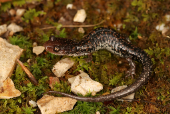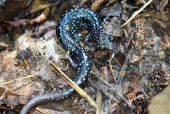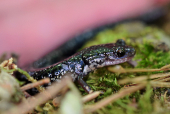Caddo Mountain Salamander (Plethodon caddoensis)
Description: The Caddo Mountain salamander (Plethodon caddoensisM) is a slender, medium-sized (90 to 100 millimeters in total length) terrestrial salamander. It is one of twenty or so members of the caudate family Plethodontidae that can be found in Arkansas. Adults of this species possess numerous tiny white spots and/or brassy flecks on the back and tail; the dorsal body color is otherwise uniformly black. The lateral body surfaces are creamy white in appearance. The throat region is distinctly pale or white. Juveniles may lack much of the lateral body coloration.
Habitat: The Caddo Mountain salamander has been found to be abundant in or near talus slopes and other rocky habitats, particularly on north-facing slopes covered by mature, mesic forests. It can also be found in secondary growth, mixed deciduous forests. During dry, hot conditions, these salamanders withdraw into underground retreats under shaded talus or in abandoned mines.
Range: Endemic to Arkansas in the south-central United States, and only known from the Caddo Mountains, a part of the Ouachita Mountains.
Found in these States:
AR
Diet: Eats small terrestrial invertebrates.
Reproduction: Following the spring mating season, females enter mines in June and usually depart by late October. Females will also nest within these mineshafts during the nesting season of late summer and early fall. Eggs are deposited individually to form grape-like clusters that are adhered to nooks and crannies within the rock strata by gluey secretions from the female. Annual clutch size varies (usually five to ten eggs) according to female body size and nutritional state. Females do not leave their egg clutches but will brood the eggs throughout the entire nesting season. Incubation of eggs requires around two months, and females exit the mine along with their hatchlings. Males are normally not found in the mines during the nesting season.
Status: Listed as Near Threatened because the continued survival of this species is dependent on the protection and rigorous management of its habitat provided by Ouachita National Forest. Without this level of protection, it is very likely that the species' habitat would be degraded and fragmented resulting in significant population declines, which would warrant an immediate uplisting. The Caddo Mountain salamander is abundant within its limited range. It can be locally threatened by habitat loss and degradation. However, most of the populations is within the Ouachita National Forest, which offers them some protection.
»» Kingdom: Animalia - Animals
»» Phylum: Chordata - Chordates
»» Subphylum: Vertebrata - Vertebrates
»» Class: Amphibia - (Amphibians)
»» Order: Caudata - Salamanders
»» Family: Plethodontidae - Lungless Salamanders
»» Genus: Plethodon
»» Species: Plethodon caddoensis - Caddo Mountain Salamander
This article uses material from the Wikipedia article "Caddo Mountain Salamander", which is released under the Creative Commons Attribution-Share-Alike License 3.0. Content may have been omitted from the original, but no content has been changed or extended.
|













